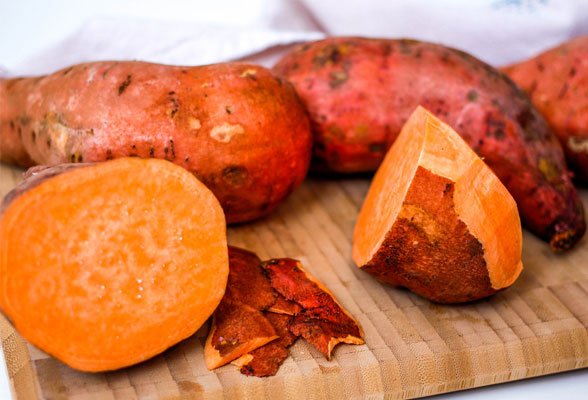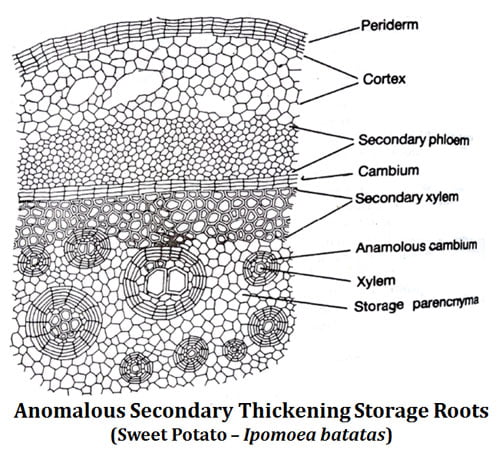Anomalous Secondary Thickening in Storage Roots (Dicots)
Ø In many dicots, the root functions as a storage region.
Ø The secondary growth in these storage roots is usually anomalous type.
Example:
Ø Secondary thickening in Beta vulgaris (Beetroot – Chenopodiaceae)
Ø Secondary thickening in Ipomoea batatas (Sweet potato – Convolvulaceae)
Ø In the previous post we have discussed the Anomalous Secondary Thickening in Beetroot (Beta vulgaris). In this, we post discuss the Anomalous Secondary Thickening in the Storage Roots of Sweet Potato (Ipomoea batatas).

Anomalous Secondary Growth in Sweetpotato
Primary structure
Ø The primary structure of the root of sweet potato is typical to the dicot root.
Ø The epidermis with numerous unicellular root hairs.
Ø The cortex is well developed, parenchymatous with wide intercellular spaces.
Ø Endodermis is well developed with prominent casparian thickening.
Ø The stele is typical, radial with pentarch to hexarch condition.
Secondary growth
Ø The initial secondary growth is normal type in sweet potato.
Ø The cambial ring formation is as usual as in normal dicot roots.
Ø Later, the cambium behaves abnormally.
Ø Cambium produce separate stands of secondary xylem and phloem embedded in parenchymatous tissue.
Ø Each strands of xylem get surrounded by an individual ring of secondary cambium.
Ø These secondary cambia are originates from the parenchymatous cells of the ground tissue surrounding the xylem vessels.
Ø The secondary cambium behave abnormally, it produce:
$ Internally: Few elements of secondary xylem
$ Externally: Few sieve elements and laticifers
Ø The abnormal cambium also produce considerable amount of parenchymatous cells towards the inner and outer sides.

Ø These parenchyma cells get filled with the reserve food material (starch) and thus they functions as the storage tissue.
Ø In later cases, the large vessels develop tyloses.
Ø The pericycle develops into cork cambium which produces the periderm.
Ø Thus the anomalous secondary growth of the storage roots of sweet potato is best suited for its storage function.
| You may also like... | ||
|---|---|---|
| NOTES | QUESTION BANK | COMPETITIVE EXAMS. |
| PPTs | UNIVERSITY EXAMS | DIFFERENCE BETWEEN.. |
| MCQs | PLUS ONE BIOLOGY | NEWS & JOBS |
| MOCK TESTS | PLUS TWO BIOLOGY | PRACTICAL |
